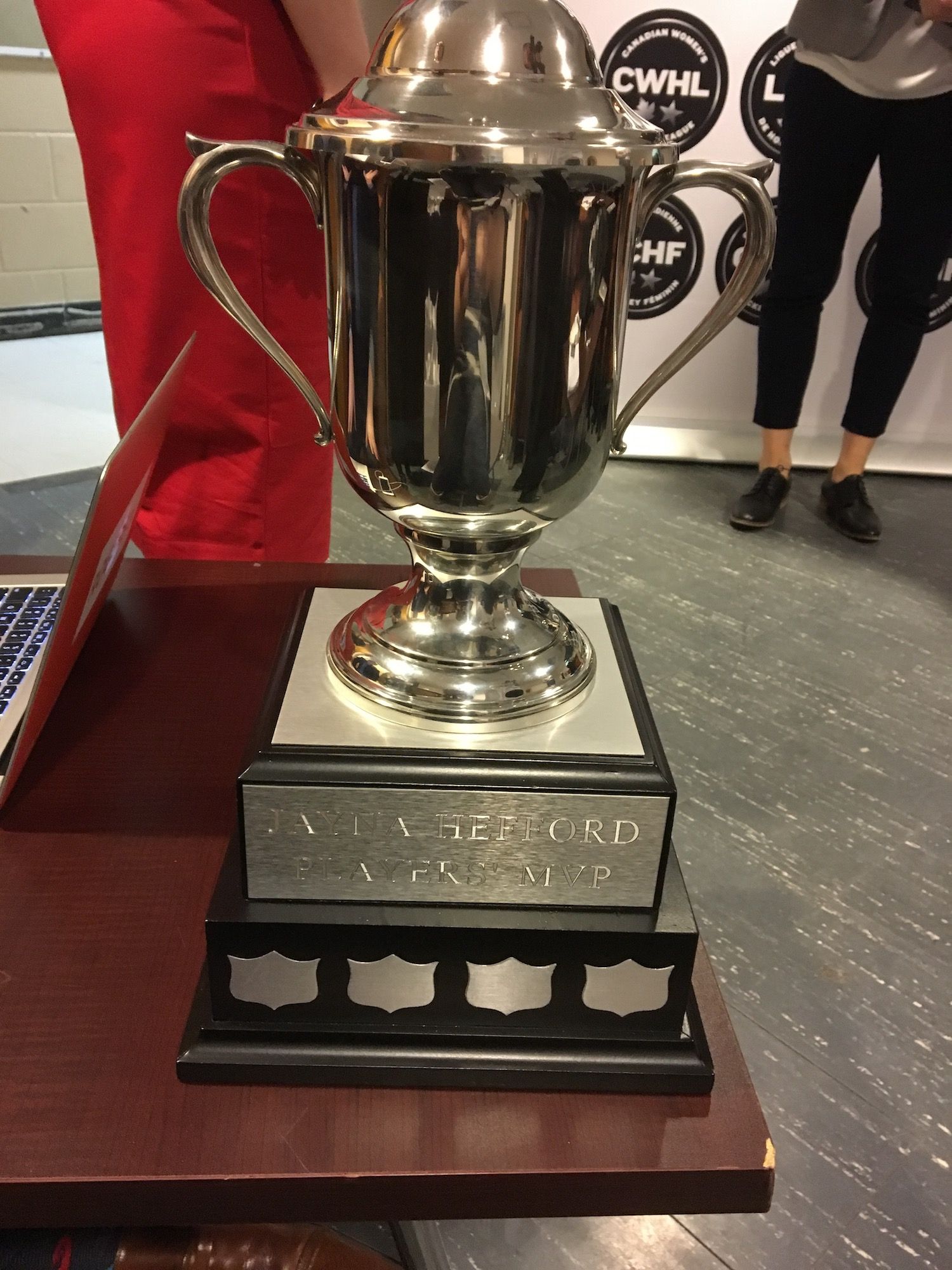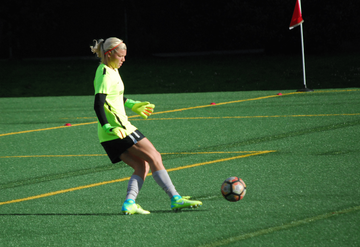As part of the month-long liquidation process leading up to the official dissolution of the CWHL on May 1, the majority of the league's trophies went up for auction this week. CWHL writer Kirsten Whelan (who you should read before ever reading anything by me) pointed out that this is part of the normal, legal process when a non-profit closes its doors with outstanding debt. Those who follow women's hockey are rightly upset, and there's been a chorus of calls for corporate saviors to intervene, and for organizations like Hockey Canada or The Hockey Hall of Fame to secure the silverware. For them to do so would be the equivalent of running into a burning museum to save a piece of art after underfunding the museum for its entire history. These organizations have never made a substantial investment in women's hockey nor cared about its history – why would they start now?
For corporate organizations like Scotiabank or Sportsnet to suddenly provided the funds they were always capable of providing to save the cultural production of a league and its players when they cared little to support them during the league's existence is an option that gives the richest institutions far too much credit. There will be no rich benefactors because they do not care. If they did, they would have prevented this from happening before it started. They would have, at the very least, stepped up immediately when word that the players still needed to be paid had leaked. They would have noticed this was happening.
What these calls ignore or choose not to believe is that there is no saviour here, at least not coming from the outside. As I'm writing this, a fan initiative led by Whelan and Jared Book has raised over $2000 in less than a day, with the express purpose of purchasing the items that the CWHL is auctioning off and preserving women's hockey history. As always with women's sports, the support, demand, and love is there, it is just not shared by certain institutions and the rich white men who control them.
While responses to the end of the CWHL must centre the athletes who played in the league and athletes who play in women's pro leagues more broadly, the question of what happens to the jerseys, mementos, and trophies – the literal material history of the league – is not an insignificant question.
As Dr. Courtney Szto wrote on Friday in her essay "Trophies Matter":
The gut wrenching part about seeing these trophies go up for sale as if they are regular commodities and not historical and cultural artifacts is because it's possible that a big part of women's hockey history could be erased... We cannot say that public memory exists for women's hockey. We are writing that history every day and we are fighting to have women included on selection committees and induction lists; therefore, those trophies need to end up in a public archive.
Dr. Szto is right to call these trophies "cultural artifacts," as the they are literally inscribed with the story of the league and its players. Not only are award winners' names added to the trophies annually, but the awards themselves bear the names of legends past. The article also makes a point ignored by many: that the Hockey Hall of Fame is both a corrupt organization and one that has a very narrow, very specific version of hockey history on display – one that centers white men. They could not be trusted to either bother securing these artifacts of women's hockey or afford them the honours they deserve.
While I agree with Dr. Szto, I would add this amendment: "Trophies Matter: Women Don't." The Jayna Hefford Trophy is for sale because the Ted Lindsay Award never would be. Put another way: the point of commemoration for most people is to highlight the achievements of white men.
At their heart, trophies are commemorative acts. They highlight extraordinary achievements of individuals and communities. They are a statement of what our collective culture values. But the point of commemoration in Canada has always been to highlight, cement, and focus attention on the deeds of white men.
While this might seem like hyperbole, think about all of the public commemorative displays you've seen in your lifetime: the monuments, statues, artworks, buildings, and parks. The vast majority celebrate the "achievements" of white men. For every monument recognizing the lived experience of women (often erected with considerable opposition from misogynists), there are hundreds of statues, monuments, government buildings, and airports named for dudes, exceptional or otherwise, and the opposition only starts when people start to pick at the narrative these remembrances are supposed to convey.
When it comes to sports commemoration in Canada, and hockey commemoration specifically, various levels of government and sports institutions would much rather commemorate and celebrate the act of a white dude giving a trophy to other white dudes than support women's hockey in any meaningful way. The Lord Stanley's Gift Monument was unveiled a year and a half ago as part of the NHL's centennial, the Stanley Cup's 125th anniversary, and Canada's sesquicentennial. The Government of Canada contributed over $2 million CAD to the project, and the City of Ottawa, the NHL, and the Ottawa Senators chipped in the rest. The trophy specifically commemorates Lord Stanley of Preston's gift of a challenge cup but was created within a framework of Canadian national identity, both by connecting the Cup's anniversary with the 150th anniversary of Canadian Confederation and by the site's own branding: "Canada is our country. Hockey is our country's game." The site literally proclaims itself as "a monument to mark the 125th anniversary of the Stanley Cup was unveiled in Canada's capital, steps from the very birthplace of hockey's Holy Grail." It goes on: "This work of public art is our country's way of celebrating one man's enduring gift to our game, just as that gift has symbolized the pinnacle of hockey excellence for more than a century."
If hockey is truly our country's sport, then the women's game surely deserves greater support and attention. But a project such as Lord Stanley's Gift, with its government and corporate backing and patrons like David Johnston and Frank Mahovlich, and competition judges like Roch Carrier and Ken Dryden, does not recognize any achievement outside of games in which men compete, nor does it recognize that pinnacles of excellence occur without men.
While the charitable organization emphasized the monument's proximity to site where Lord Stanley gifted the bowl, it also places it at the heart of Ottawa's – and Canada's – ceremonial landscape. That's not an accident. It is designed to be part of a commemorative space that includes significant sites such as the National War Memorial, Parliament Hill, and the Supreme Court of Canada. It is a restatement of ownership: ownership of an award Canadians haven't independently controlled for decades and a Canadian team hasn't one in over a quarter of a century.
Putting this monument within the same space, geographically and figuratively as Canada's political and martial "achievements" creates specific impressions. Namely, it conveys that the things which form the white, Anglo Canadian identity (like democracy, multiculturalism, individual rights, and Hockey Night in Canada) exist because of the achievements of heroic, white men. White men are commemorated on Parliament Hill as the "builders" of the nation [1], and at the National War Memorial, where the Unknown Soldier acts as a specific figure of white heroic masculinity, sacrificing to secure the freedoms of marginalized peoples in this country. It's not a stretch to envision the winners of the Stanley Cup as similarly heroic – this characterization happens every spring.
The point of commemoration is to honour white male achievement. The point of commemoration is to centre the actions of white men. The point of commemoration is to enshrine in public memory a very narrow definition of achievement, a narrow understanding of identity, and a narrow distribution of public support. Only by dismantling the power structure and changing the way we allocate support and resources can we make commemoration about something else – something better, and something more meaningful than just who had the money and the power at the time to acknowledge that something important happened.
[1] Yes, there are monuments of women on Parliament Hill, but none are positioned as "nation builders." Queens Victoria and Elizabeth II are commemorated as monarchs and the faces of the British Empire and the British Commonwealth respectively. The other monument is for the Famous Five (Albertans Irene Parlby, Louise McKinney, Nellie McClung, Emily Murphy and Henrietta Muir Edwards) to commemorate the Persons Case and the group's decision to appeal the Supreme Court of Canada's ruling that women weren't "persons" under the law in 1928-29. While the achievement was no doubt important for the advancement of white women's rights in Canada, they were also influential in Canada's eugenics movement and helped get legislation passed in Alberta that led to the sterilization of 3000 marginalized people, many of whom were Indigenous. Rather than undermine Parliament Hill's commemorative narratives, these monuments reinforce narratives of white supremacy.
(Photo: Zoë Hayden)







